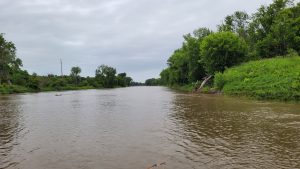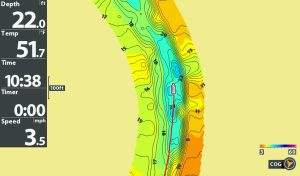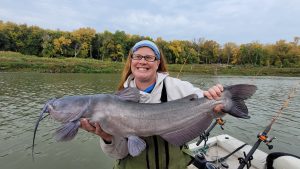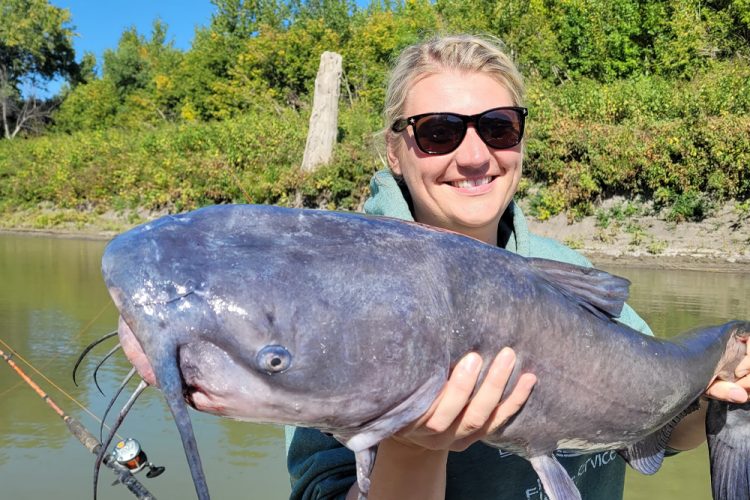Amber, a client of the author, holding a large channel catfish in new waters during a fairly aggressive time.
This fish was caught on an outside bend in the ON current seam.
Channel Catfish Tactics: Breaking Down New Water
Story and photos by Brad Durick
Breaking down rivers for channel cats is easier than you might think. Basic knowledge of a river and current mixed with the use of modern-day technology can make it very easy.
As catfish anglers we have different goals. Some of us have our home body of water that we stick to, and others such as tournament anglers travel to many areas of new water. Whichever one you are, we all have different ways of breaking down new waters.
From my observations over the years, it seems most anglers drive a new stretch of river searching out the holes and picking the best-looking ones that are more attention grabbing. They may stop and fish them along the way or save them for later.
Others nowadays break out the side imaging and take a look at everything before finding the area they want to fish. Then, of course, there are the anglers who look for something that just looks “fishy” and start.
How I Learned to Break Down Rivers

When I started this game of catfishing, I did just that. I would look for bends in the river and find the holes. Back then, all I had was a flasher, so it could take an entire summer to learn an area or two that held fish. After a couple years, I graduated to a graph where I could at least see what I had covered and sometimes even mark a fish to draw me into stopping and fishing a spot.
Shortly after the release of side imaging in 2007, I bought a unit that would side image. Back then it was so new that there were no YouTube videos or articles to teach you how to read it. It was go out and stare at the thing until you learned what you were looking at. Even with that, what took an entire summer to learn with a flasher could be learned in just a few minutes with side imaging. You could see the head of a hole, breaklines and any structure that was there.
A couple years later, live mapping was added to most depthfinders, and GPS became standard equipment. This is where my life as a catfish angler changed forever. Now you could make a map of the spots and see with side imaging at the same time. You could know literally everything about a spot in just a few seconds.
Now, I also learn how channel catfish relate to current seams, breaking the pattern down to ON vs OFF current. If the fish are active, they tend to be ON current. If they are negative, such as after a storm front or some drastic change in conditions, they will be OFF current.
How I Break Down Rivers for Channel Catfish in 2024

In late 2023, I was guiding daily in an eight-mile section of river. I was very deliberate in resting spots for five days after I fished them. This tends to keep spots recycled and active. For weeks, I was working this eight-mile stretch of river and rotating spots, but I started to notice that I was not catching as many big fish as I once had. I wondered if I had “burned” the area due to overfishing even with a five-day rest on spots.
I have always tried to utilize technology and the current pattern to find a new spot or two per week. With a detailed map, side imaging and a solid pattern, this is a very achievable goal.
Back to the fall of 2023. I needed to get out of the eight miles and expand range to stay on good fish. I had the river mapped, but I like to keep lines in the water rather than long boat rides with customers. I took a group to the end of the eight miles and started the day. Using the map and the solid ON current pattern we had been on, we started working our way through sections of river I was not familiar with. Success was almost immediate, with more big fish coming into the boat.
It took one cold front to push the fish to an OFF current pattern, but with the knowledge from the first trip, I was able to go to the same general spots but shifting to the OFF current side of the river. If something in the current didn’t look right, I turned on the side imaging to take a look at what was below.
Of course, not all of the new spots worked great. Some didn’t, but most did. In just over two weeks, I collected 25 new coordinates and learned most of five miles of new river.
Simple Ways to Break Down River

To break down river with or without technology, look at the boils on the surface of the water as it runs from the main drop-off from the channel to the bank. You can see on the bends of the river where the water is crashing in causing the ON current. On the opposite side, you can see where it is pushing away. Use a depthfinder to find the drop-offs that are on these boils.
From there it is a matter of finding the bends and figuring out which side of the current the fish are biting on. Then repeat the pattern as the fishing day goes on.
Should your river have lots of laydowns and snag piles, fish them as well, while noticing how the current is pushing into them or pulling away from them.
If you have mapping software, use it to draw the map showing you precisely where the breaklines and holes are. From there, use the visual to best match the pattern to the active fish.
Over time, you will learn to read the spots, quickly find the pattern that works and repeat it. If you have GPS, mark the spots that are successful for future needs to help make patterning even faster. It really is that easy.
(Captain Brad Durick is a nationally recognized catfish guide on the Red River of the North, seminar speaker, and author of the books Cracking the Channel Catfish Code and Advanced Catfishing Made Easy. For more information go to www.redrivercatfish.com.)



